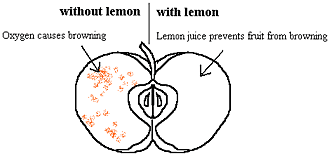|
Apple Chemistry
A. Starch
Apples naturally contain a carbohydrate known as starch. As apples
ripen, the amount of starch decreases as it turns to sugar. Starch
is converted to sugar near the core of the apple first, and next
to the skin last. Apples are ripe when most of the starch becomes
sugar. An iodine test is a simple way to see whether an apple
is ripe.
Experiment:
The Starch-Iodine Test
You will need:
brown iodine
a small paintbrush
an apple
a knife
Instructions:
Cut the apple in half and brush some iodine onto the cut surface.
If there is starch in the apple, parts of the apple become a dark
purple colour. The amount of purple found on the apple after completing
this test indicates the amount of starch remaining in the apple.
If the apple has only a little bit of purple, it is probably ripe
and ready to eat.
You may want to do
a starch-iodine test on a potato, too. Potatoes are high in starch
and will turn mostly purple. Compare the starch in a potato to
the starch in an apple.
Note: Do not use apples
that have been kept in storage for this experiment, because most
of their starch has already disappeared!
B. Browning
Why does a cut apple turn brown?
When peeled fruit is
sliced, oxygen in the air reacts with natural chemicals in the
fruit to make it turn brown. There are two ways to avoid this:
1) the easiest is to eat the fruit right away; 2) you can toss
the cut up fruit in a little bit of orange or lemon juice. Orange
and lemon juice contain Vitamin C, and Vitamin C is a natural
antioxidant and prevents oxygen from turning the fruit brown.

<
Back to Table of Contents!
|

